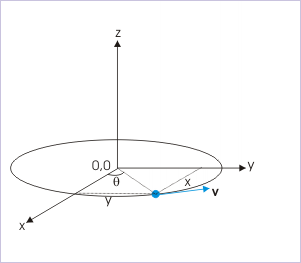| << Chapter < Page | Chapter >> Page > |
The position vector of a particle in circular motion is given in terms of components as :
Position vector

1: Velocity
The velocity of the particle, therefore, is obtained by differentiating with respect to time,:
where ω = dθ/dt is angular velocity. Also note that velocity is directed tangentially to path. For this reason, velocity vector is expressed with the help of unit vector in tangential direction.
2: Acceleration
The acceleration of the particle is obtained by differentiating the above expression of velocity with respect to time. However, as the radius of the circle is a constant, we take the same out of the differentiation,
Thus, we see that :
The above expressions, therefore, give two components of total acceleration in two specific directions. Again, we should emphasize that these directions are not the same as coordinate directions.
The derivation of acceleration components for two dimensional motion has, though, been carried out for circular motion, but the concepts of acceleration components as defined here can be applied - whenever there is curvature of path (non-linear path). In the case of rectilinear motion, normal acceleration reduces to zero as radius of curvature is infinite and as such total acceleration becomes equal to tangential acceleration.
In order to illustrate the features of two dimensional motion, we shall consider the case of elliptical motion of a particle in a plane. We shall use this motion to bring out the basic elements associated with the understanding of acceleration and its relation with other attributes of motion.
It is important that we work with the examples without any pre-notion such as “constant” acceleration etc. The treatment here is very general and intuitive of the various facets of accelerated motion in two dimensions.
Problem : The coordinates of a particle moving in a plane are given by x = A cos(ωt) and y = B sin (ωt) where A, B (<A) and ω are positive constants. Find the nature of path of motion.
Solution : We shall use the general technique to find path of motion in two dimensional case. In order to find the path motion, we need to have an equation that connects “x” and “y” coordinates of the planar coordinate system. Note that there is no third coordinate.
Elliptical motion

An inspection of the expressions of “x” and “y” suggests that we can use the trigonometric identity,
Here, we have :
Similarly, we have :
Squaring and adding two equations,
This is an equation of ellipse. Hence, the particle follows an elliptical path.
Problem : The coordinates of a particle moving in a plane are given by x = A cos(ωt) and y = B sin (ωt) where A, B (<A) and ω are positive constants. Investigate the nature of velocity and acceleration for this motion. Also, discuss the case for A = B and when "ω" is constant.
Solution : We can investigate the motion as required if we know expressions of velocity and acceleration. Therefore, we need to determine velocity and acceleration. Since components of position are given, we can find components of velocity and acceleration by differentiating the expression with respect to time.
1: Velocity
The components of velocity in “x” and “y” directions are :
The velocity of the particle is given by :
Evidently, magnitude and direction of the particle varies with time.
2: Acceleration
We find the components of acceleration by differentiating again, as :
Both “x” and “y” components of the acceleration are trigonometric functions. This means that acceleration varies in component direction. The net or resultant acceleration is :
3: When A = B and "ω" is constant
When A = B, the elliptical motion reduces to circular motion. Its path is given by the equation :
This is an equation of circle of radius “A”. The speed for this condition is given by :
Thus, speed becomes a constant for circular motion, when ω = constant.
The magnitude of acceleration is :
Thus, acceleration becomes a constant for circular motion, when ω = constant.

Notification Switch
Would you like to follow the 'Physics for k-12' conversation and receive update notifications?